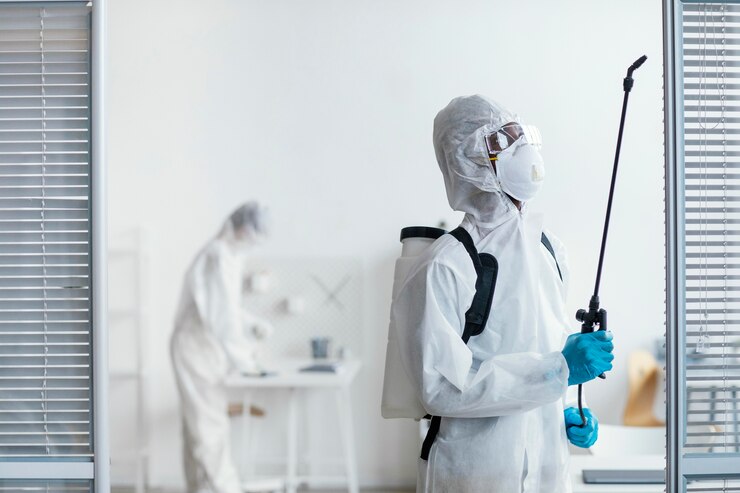When you schedule pest extermination services, preparation is key to ensuring the process is effective and efficient. Whether you're dealing with a minor pest problem or a full-blown infestation, taking the right steps can significantly improve the results of the extermination treatment. This article will guide you through the essential preparations you should make before the exterminators arrive at your home.
1. Clear the Area Around the Infestation
The first step in preparing your home for pest extermination is to identify the areas of infestation. Once you've pinpointed where the pests are most active, clear the area of any items that could obstruct the exterminator’s work.
- Remove Furniture and Belongings: If the infestation is in a specific room, move furniture, toys, and personal items away from walls and corners. This will allow the exterminators full access to the affected areas.
- Tidy Up: A clean environment allows the exterminators to see the problem areas more clearly. Vacuum the floors and surfaces to remove any debris, crumbs, or pests before the extermination begins.
2. Secure Food and Dishes
One of the primary concerns during pest extermination is ensuring that food sources are eliminated to prevent further pest attraction. Follow these guidelines to secure food items in your home:
- Store Food Properly: Place all food items in sealed containers or the refrigerator. This includes pet food, snacks, and any open boxes or bags of food in your pantry.
- Wash Dishes: Clean and put away any dirty dishes before the exterminators arrive. Ensure that all cookware and utensils are stored in cabinets or drawers.
- Remove Open Food: Discard any food that has been contaminated or is sitting out in the open. This includes fruits, vegetables, and any leftovers that may attract pests.
3. Prepare Pets for Extermination
Your pets’ safety is paramount during the pest extermination process. Certain chemicals used in pest control can be harmful to animals, so it’s essential to make the following arrangements:
- Relocate Pets: Consider temporarily moving pets to a friend or family member’s home during the extermination. If that's not possible, confine them to a room that is not being treated.
- Keep Pet Supplies Accessible: Ensure that your pet’s food, water, and bedding are easily accessible but not in the areas where the exterminators will be working.
- Consult Your Exterminator: Speak with the pest control company about any specific precautions they recommend for pets. Some companies may have specific guidelines based on the products they use.
4. Inform the Exterminators of Previous Treatments
Transparency is crucial when preparing for pest extermination. Inform the exterminators of any previous treatments or pest control methods you’ve used. This information can significantly influence the success of the new extermination plan.
- List Products Used: Provide details about any over-the-counter pest control products you’ve tried, including sprays, baits, or traps. This will help the exterminator choose the most effective treatment for your situation.
- Mention Signs of Infestation: Describe the specific pests you’ve encountered, where they’ve been seen, and any signs of damage or nests. This information will help the exterminators target their treatment effectively.
5. Ensure Access to Your Home
To facilitate the extermination process, make sure that the exterminators have easy access to your home, both inside and out. Here are a few things to consider:
- Unlock Gates and Doors: Ensure that all entry points, including side gates, doors, and windows, are unlocked. This allows the exterminators to access all necessary areas without delay.
- Remove Obstacles: Clear any items from walkways, porches, or patios that could obstruct the exterminators' access to your home.
- Communicate Any Security Features: If you have an alarm system or security cameras, inform the exterminators beforehand. Provide them with any necessary access codes or instructions to ensure they can enter your home without issues.
6. Follow Up on Recommendations
After the extermination process, your pest control company may provide specific recommendations for follow-up care and prevention. It’s essential to adhere to these guidelines to maintain a pest-free environment:
- Understand the Treatment Plan: Make sure you fully understand the extermination treatment and any follow-up treatments that may be necessary.
- Implement Preventive Measures: Follow any advice on how to prevent future infestations. This may include sealing cracks, fixing leaks, or changing cleaning habits.
- Schedule Regular Inspections: Consider scheduling routine pest inspections with your extermination service to catch any potential problems before they escalate.
7. Be Patient and Stay Informed
Finally, patience is vital when dealing with pest extermination. The results may not be immediate, and it’s essential to give the treatment time to work.
- Monitor for Activity: Keep an eye out for any signs of pest activity after the extermination. If you notice any persistent issues, contact your extermination service for further assistance.
- Educate Yourself: Take the time to learn about common pests and prevention methods. Understanding pest behavior can help you maintain a pest-free home in the long run.
Conclusion
Preparing your home for pest extermination services is an essential step to ensure a successful outcome. By clearing areas of infestation, securing food and dishes, relocating pets, and providing the exterminators with important information, you can help facilitate a smooth extermination process.
Remember to follow any guidelines provided by your pest control company and stay vigilant about monitoring for any signs of pest activity. With careful preparation and attention, you can create a safer and more comfortable living environment free from unwanted pests.





Comments